The date was October 6 1951 and the Captain Gill Garrett was flying his sortie #97 in the F-86A Sabre BuNo 49-1319, 334th FIS of 4th FIW, as leader's wingman of a group of 4 Sabres. Two squdrons (his own and the 336th) were doing a CAP over the "MiG Alley", a zone near the Yalu river, the border between China and North Korea, and also the area where the MiG-15s flew by the Communist pilots were more active. Garrett waited to end without trouble this one and the three remaining sorties left to complete the 100 of his tour, or even perhaps with some kill in his account. As a matter fact, he already had participated in 35 engagements and he also had seriously damaged a MiG, all without suffering a single scratch. But his luck was over that day, as the own Garrett explained:
The two MiGs had led us straight into a trap. They had two buddies who now were cutting down on us from our flank at a time when we were at our lowest air speed.
A MiG bore down on me and began firing with his 37 mm. and 23 mm. cannons. I could see that mean-lookining red nose gun flash when my ship bucked, skidded around and head down. I had been hit - but good. A shell had slammed into my engine just aft of my right wing. The force of the blast had trown the plane around and into a spin. One second I was in the middle of the fight the next I was on my way out with a GI insurance policy due to mature."
Garrett had the bad luck to meet that day one of the best MiG-15 pilots never sent to Korea, who also was the commander of the 196th IAP of 324th IAD of the VVS (Voyenno Vozdushnye Sily, Soviet Air Force): Colonel Yevgeni Georgievich Pepelyayev.
A little promising beginning
Yevgeni Pepelyayev was born on March 18 1918 in Bodaybo, Irkutsk (Eastern Siberia), son of a railroad worker. Even when he learnt and worked in his youth in hisfather's proffesion, he felt atraction for the aeronautics since his childhood, and when his elder brother Konstantin enlisted in the Soviet air force, he looked for job in Odessa as assistant in the aeroclubs of the city, with the intenttion of following his brother's steps later.
He graduated in 1938 from the 8th Military Pilots School and was sent to serve in the regiments deployed in the Soviet Far East. When the German invasion to the USSR began in June 1941, he requested several times to be transferred to the battle front, and those requests were more frequent after the death in combat of his brother Konstantin. With the only exception of a short period when he play as instructor of the 162nd IAP about late 1943, those requests were always rejected. And in this lone instance, the bad weather reduce his battle chances to recce flights. In one of them, his Yak-7 was attacked by German planes and seriously damaged, even when Pepelyayev could return to his base. In 1945 his unit, the 300th IAP, participated in the operations against Japan in Manchuria, and he performed 30 sorties, finding no aerial opposition during them.
| Photo of Yevgeni G. Pepelyayev taken in August 1945, when he was 27 years old, posing besides his Yakovlev fighter few time after the USSR's declaration of war against Japan. His unit, the 300th IAP, supported the advance of the Red Army over Manchuria. In that period Pepelyayev flew 30 sorties, distributed between escort missions and recce missions. However, due to the weakness of the Japanese (remember that those are the final days of WWII) almost there was no enemy fighters in the air, and Pepelyayev ended the war without any shootdown in his score. That would change six years later. | 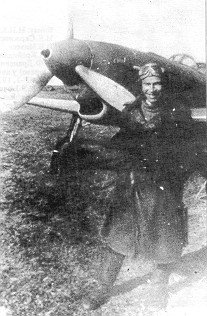
|
In 1947 he graduated in the VVS Academy and he married with his first girlfriend, Maya. Even when his flight habilities and command capacities didn't remain unappreciated -he was promoted from a deputy commander of squadron to deputy commander of the 196th IAP- certainly nothing seemed indicate that this 29 years old officer would be one of the top aces of the typical post-war conficts caused by the "Cold War".
The USSR gets into the Korean War
When in October 1950 the Colonel Pepelyayev recieved the command of the 196th IAP, the War of Korea was in its climax, with the UN troops and air forces (leaded by USA) entering in North Korea after defeating the initially succesful North Korean invasion to South Korea. Both Josif Stalin and Mao-Tse-Tung decided do not see how a Communist allied (Kim Il Sung) was defeated without move a finger. With a big secret, the USSR sent several air regiments equipped with the new MiG-15s to the Chinese base of Andung (in Manchuria) with the mission to support the Chinese counter-strike. In a short period of time the Soviet fighters transformed the southern shore of the Yalu river in the most dangerous area for the UN aviation, zone that received the nickname of "MiG Alley".
Both sides deployed their best fighters in a try to obtain the air superiority.
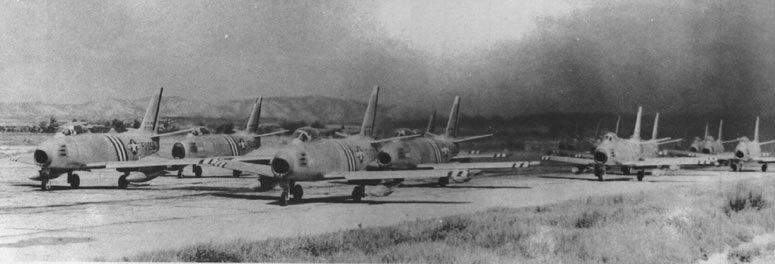
|
| Above: several F-86A Sabres of the 4th FIW ready to take off from Kimpo right to the "MiG Alley". Right: Even when this photo of Soviet pilots preparing themselves to ride their MiG-15s is taken in an airbase of the USSR, it illustrate perfectly the aspect and the activity existing in Andung since late 1950 until July 1953. | 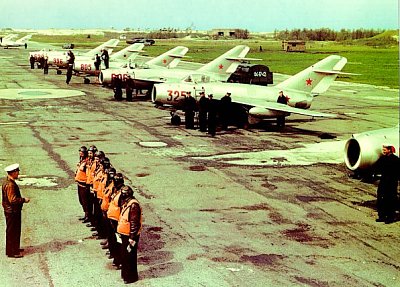 |
Anyway, the arrival of the fighters F-86 Sabre of the 4th Wing of the USAF in December 1950 turned the tables in favour of the UN again. It was decided to create the 64th IAK (Fighter Corp) with two fighter regiments and to assign them the best available pilots. The chosen units were the 176th GvIAP y 196th IAP (the Pepelyayev's unit) of the 324th Division and the entire division was put under the command of the best possible man: Colonel Ivan Kozhedub, three times awarded with he Golden Star of the Heroe of the Soviet Union (the highest Russian military award) and Top Scoring Soviet Ace of the WWII with 62 victories against the German Luftwaffe.
Pepelyayev arrives to Andung
The 196th Regiment arrived to Manchuria in January 1951, and was in second-line airfields until complete the training of the pilots and their familiarization with the temperamental MiG-15 with Kimov RD-45 engine, and was later deployed to Andung. On April 1 both regiments were finally commited to combat, but their results weren't good initially. The reason was simple: in an attempt to keep in secret the Soviet injerence, to flight over UN controlled areas or the sea was forbidden to the Russian pilots (due to the fear of being downed and captured), and their MiGs carried Chinese roundels. But the worst thing was the order of speak only Korean or Chinese language in the radio. It caused a lot of complains from Pepelyayev and Lt.Col. Sergei Vishnyakov, CO of the 176th GvIAP. As the own Pepelyayev explained:
It was impossible psychologically in the heat of battle to use a foreign language you hardly knew. So after a week or two we just decided to ignore the order. The top brass started complaining, so I told them: 'Go and fight yourselves''
Col. Kozhedub supported his subordinates in front of the commander of 64th IAK, Lt.Gral I.V.Belov, and due to Kozhedub was one of the Stalin's "favourite sons", the High Command of the VVS finally gave up and allowed that the pilots speak Russian in combat. That caused an immediate raise in battle efficiency, which reach its peak on April 12 1951, when 36 MiG-15s of the 176th GvIAP and 196th IAP intercepted an American formation of 48 B-29s of the 19th, 98th and 307th BW (Bombing Wings) escorted by 34 F-84s and 18 F-86s when they tried to attack the bridges thru the Yalu. In the following battle three B-29s were shot down and seven more were seriously damaged, all that against the loss of a single MiG due to a Sabre.

Col. Yevgeni Georgievich Pepelyayev was one of best MiG-15 Fagot pilots and was also one of the Top Aces of the war. He commanded the 196th IAP, 324th IAD, and he obtained 23 kills in Korea -19 were official and the other 4 were possible victories- distributed among 12 F-86s, five F-80s, four F-84s and two F-94s. His first victory happened on May 20 1951 (a F-86), and the last one occured at the beginning of the next year, on January 15 1951, against a Sabre too. But he obtained his most famous air-to-air victories on July 11 and October 6 1951 (both Sabre kills). | 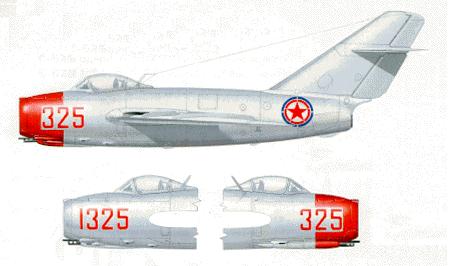
Drawing of the MiG-15bis Fagot # 1315325 ("325"), plane used by Colonel Yevgeni Pepelyaev on October 6th 1951 to shotdown the F-86 BuNo 49-1319. With this aircraft Pepelyaev obtained 17 of his 19 official air victories. |
First victory
May 20 1951 meant the end of three weeks where both sides were relatively quiet. That day a force of 50 MiGs fought with 28 Sabres, and during that combat both sides claimed more shootdowns that the ones actually obtained (three claims the USAF side and four ones in the VVS side). The truth is that both sides lost only one plane each: a pilot of F-86 Sabre of the 334th FIS, Captain James Jabara, shot down one of the Pepelyayev's men, Captain Nazarkin, and in retaliation the commander of the 196th IAP, flying the MiG-15bis Fagot # 1315325, shot down one F-86; as indicates the after-battle report presented by Pepelyayev:
"...on 20 May 1951, during the period of 1508-1558 hours, during an air battle with a group of F-86 Sabres I fired at an F-86 at a range of 500-600 meters. At the time of my firing, I noticed shell strikes along the enemy's right wing, after which the aircraft went from a bank to the left into a right turn."
It must be noted here that he do not claim any shootdown directly; he do not say "I shot down an F-86" but he simply describe what really happened, and such style is typical in all his reports. The confirmation of his victory would come from the Chinese ground troops, which capture the pilot of the F-86 downed by Pepelyayev. Unfortunately, even when the Chinese give the pilot's name to the Soviets, they changed the spelling in such way that even today is imposible to know who was this pilot (USAF never gave a complete list of the Sabre pilots taken prisoner), sending also the flight suite, the helmet and other pertenencies. This unknown pilot became that way in the first of the 19 victories credited to Colonel Pepelyaeyev.
 Yevgeni G. Pepelyayev, this time taken in 1951, whe he already was Colonel and he was 33 years old. Many people considered him too old to fly an exigent plane as the MiG-15, but he would demonstrate that sometimes the experience compensate the reflexs' reduction that came with the age. Such a prejudice wasn't an Russian prerrogative: Joseph McConnell, the Top American F-86 Ace, 28 years old in 1952, was considered too old to be a Sabre pilot | 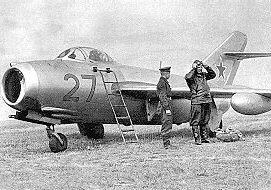
Colonel Pepelyayev in the USSR in the late 1950, after a routine flight with the (at that time) new MiG-15; few time later his regiment would be send to Andung |
On July 11 Pepelyayev scored another important victory when he downed other F-86 which pilot was captured, and even when again the Chinese failed to indicate his name to the VVS, it is also known that this pilot was interrogated by the KGB in an attempt to obtain information. This pilot mentioned the weak points in the F-86A, such the low climbing-rate and the loss of thrust and maneuverability at alttitudes higher than 10,000 meters (about 30,000 feet). That information would allow to develop better tactics in the following months. Few days later, on July 21, Pepelyayev and Captain Boris S. Abakumov intercepted what they identified as a F-94 formation, and both devastated it: Pepelyayev shot down with his MiG-15 two of the enemy aircraft, and so did Abakumov with a third one. The Chinese search teams confirmed the three shootdowns, because they found the remains of all the planes. In the case of Pepelyayev's kills, the Chinese could identify a serial number in one of the wreckages -"109-I-405116"- and also found the death bodies of both pilots in the crash sites. The pilot of the "F-94" downed by Abakumov was a little bit more lucky, because he could eject, only for being captured later. The only one thing wrong in the claims of both Russian pilots was the type of plane: there was no F-94s in Korea until 1952,and as amatter of fact the downed planes were F-80Cs with a special fuel tank -"Misawa"- that gave the Shooting Star a profile similar to the F-94 (after all, the F-94 Starfire is the night fight two-seat version of the F-80)
The Sabre's Hunter
But the most important MiG-15 victory of this period happened on October 6 1951, when Colonel Pepelyaev (flying the MiG-15bis Fagot # 1315325 again), during a battle among 10 MiGs belonging to his regiment and 16 Sabres of 4th FIW at 8,000 meters (about 24,000 feet), he downed a F-86 with 37 mm ammunition. In first place he organized the engagement and later himself performed an attack against the leader of the heading pair of Sabres, firing against him at 550 meters (yards), without confirm the results of the attack, due to the second pair of Sabres also attacked both -Pepelyaev and wingman- MiGs almost in a head-on attack (according the Pepelyaev narration, from 1 or 2 o'clock). On the own Pepelyaev words:
"I remember this battle as if it happened yesterday. Their leader opened fire on my aircraft and ripped off a piece of the air intake...I remembered a maneuver developed by me and my friends, when we were trying to develop new tactics. During head-to-head attacks, when both aircrafts are trying to get on each other's tail, one of the maneuvers was to indicate a 'boevoj razvorot' [combat turn in Russian - Note of Vlad "PG Monster" Arkhipov] to one side, but then to make a sharp turn to the other side and follow the opponent. When the enemy aircraft wouild exit from the combat turn, I would end up on its tail. That's what happened that time. When I passed the Sabres on the head-to-head course, they initiated a right turn while rapidly gaining altitude. I, on the other hand, continued to fly level for a while, and then begun turning to the right, towards the Sabres. When I achieved a turning angle of between 40-50deg, I initiated a sharp left turn and ended up behind the lead Sabre slightly above it and to the right.
It was almost directly in front of me, just over 100 meters away. I pushed the stick, trying to align with the Sabre. However, the targeting indicator would always be above the Sabre, while at the same time negative g would try to pull me out of the cockpit. Then I rolled upside down so the g-force would press me into the seat; it's more convenient to aim that way. As soon as I rolled, the Sabre did the same thing, but by then I already got the targeting indicator over him, and I opened fire from a distance of 130 meters. A 37 mm shell hit him directly behind the cockpit. There was an explosion and the Sabre started to losing altitude. I did not follow him: after such a hit there was no reason to pursue him."
 |  |
These images were captured by the gun camera connected to the 37 mm cannon belonging to the plane MiG-15bis Fagot # 1315325 piloted by Col. Yevgeni Georgievich Pepelyaev on October 6th 1951. In them appear the plane F-86A BuNo 49-1319 flew by Captain Gill M. Garrett perfectly placed in the fire line. The first photograph was taken at 130 meters, and the second one at 122 meters.
The Sabre's pilot, Captain Gill M. Garrett, used all his habilities to land upon his damaged plane in the Sokhoson Bay (East China Sea), and the American pilot was rescued by a SA-16 Albatross seaplane. It must be noted that the Sabre leader of the one hit by Pepelyaev, gallantry tried to provide cover to his wingman during the time after being hit until it landed in the sea shore; but it was seen by a group of MiG-15s of the 176th GvIAP, leading by the unit's deputy commander, Captain Konstanin Sheberstov, who apparently shot it down. American sources admitt the loss of two Sabres that day, the one downed by Col. Pepelyaev, piloted by Captain Gill Garrett (not classified as "shootdown" but as "forced to land") and the F-86E BuNo 50-671, most likely Sheberstov's victim. The same sources mentioned a third Sabre damaged, and that one could be the plane attacked by Pepelyaev in the beginning of the air battle.
Garrett's Sabre left almost intact under a few inches of water. It was gold for the USSR: finally an oportunity to get a look to the best USAF fighter jet, and the Soviet technicians took the chance: a special team leaded by the Engineer Kazankin achieved to rescue the damaged plane, put it on a truck and sent it to USSR (after a dangerous travel where the American B-26s tried to destroy the remains of the Sabre).
| 
| 
|
| Above:
This picture shows the aspect of the F-86A Sabre BuNo 49-1319 when it was rescued from the East China Sea waters. This plane was sent to USSR. Left:
During the air engagement with the Sabre 49-1319 happened on October 6th 1951, the MiG-15bis "325" was slightly damaged by 12,7 mm (0,50") bullets. The upper picture shows that damage, while the picture below shows the "325" after repairs. |
Few days later -October 8- Pepelyayev's MiG-15 received an addittional mark, due to the Colonel scored a new kill (confirmed by USAF): one F-84 of the 182 FBS, which pilot -Earl Harbour- perished when his aircraft crashed near Syukusen.
An Amazing Final Act
Since November 1951 until January 1952 both sides tried to achieve the air superiority over the Yalu, or at least tried to deny it to the enemy, and in consequence the intensity of the aerial combats reached peaks not seen before. It was a good time for the aggressive fighter pilots both Soviets and Americans, and Pepelyayev was amoung them. On November 27 he shot down an F-84, the one piloted by Bernard Seitzinger -who died- and the next day, November 28 1951, was even better: flying his famous MiG-15bis Fagot # 1315325, Yevgeni Pepelyayev knocked-out one F-86, and later put himself at 6 o'clock of another Sabre, which pilot was forced to bailed out after a few bursts of 37 mm. This particular pilot resulted to be 1st Lt. Dayton W. Ragland, who performed with another partner an audacious strike against North Korean airbase of Uiju 10 days before, destroying four MiGs in the ground. He even claimed to shot down another MiG in air combat precisely few seconds of being downed by Pepelyayev. Yevgeni would obtain his kill #16 the day after, after shooting down another Sabre, which pilot couldn't eject and was kiled when his plane crashed near Syukusen.
 |  |
One of the MiG-15 Fagot victories during the last months of 1951 was the one that can be seen in these pictures, obtained on November 28th 1951 by Col. Yevgeni Pepelyaev. It was a Sabre belonging to the 4th FIW, most likely the one piloted by 1st Lt. Dayton Ragland, who bailed out and became POW. He would obtain two more confirmed air-to-air kills on December 1st (F-80) and December 6th (F-86), but, as a matter of fact -according to USAF data-, he shot down his last Sabre on January 15th 1952. His victim was 1st Lt. Vernon Wright.
The next three victories (one F-80 on December 1, one F-86 on December 6, and another more Sabre on January 11 1952) have no confirmation yet in the American side, but ironically a victory that was originally clasified as "probable" had been finally confirmed by American sources: the F-86 attacked by Pepelyayev on January 15 1952 -which he didn't confirm as shot down- was the one piloted by 1st Lt. Vernon D. Wright, who was captured and repatriated in 1953.
Hero of the Soviet Union
After all this performance, wasn't a surprise when, on April 22 1952, Colonel Yevgeni Pepelyayev was awarded with the Golden Star of the Heroe of the Soviet Union. A particular characteristic of the ceremony was that Pepelyayev have civilian clothes, and in the speech there was no mention of the actions why he deserve the award. The need of keep the secret caused that such story repeated 21 times more, with each Soviet pilot who were awarded during the Korean War.
Besides his impressive record as fighter pilot, his charisma as leader shouldn't be understimated. He knew how to motivate his men, obtaining the top of his capacities, but also facing the Top Brass when it dictated stupid rules of engagement that expose his pilots to an unneccesary risk. His unit recorded more than100 kills during 10 months (30 o 35 of them will be probably fully confirmed), loosing just 10 MiGs in action and suffering the lost of 4 pilots KIA. Excluding him, another seven pilots of the 196th IAP became Aces: Fiodor Shebanov, Boris Abakumov, Boris Bokach, V.N.Alfeyev, A.M.Kochegarov, I.K.Shelomonov and Lev Ivanov.
During a recent interview in Russia (where he is now a celebrity) a journalist asked his opinion about the Korean War, he answered:
"For us, Korea was both a love and an anguish. Back in the 50s we were defending North Korea, and we learned to care for the people. We also felt love for the Chinese people, on whose land our regiments were stationed. But I lost friends there. Soviet pilots lie in the Russian cemetery at Port Arthur. I still remember those sorrowful moments when they buried my fellow servicemen, excellent pilots, my wingman Sasha Roshkov, Fedya Shebanov,...."
Diego Fernando Zampini.
(dzampini@hotmail.com)
Glossary:
Acronyms used in the text:
- FIS = Fighter Interception Squadron.
- FIW = Fighter Interception Wing.
- IAP = Istrevitelnye Avia Polk: Fighter Aviation Regiment.
- IAD = Istrevitelnye Avia Divizya: Fighter Aviation Division.
- IAK = Istrevitelnye Avia Korpus: Fighter Aviation Corps.
- BW = Bombing Wing.
- FBS = Fighter-Bombing Squadron.
- CAP = Combat Air Patrol.

